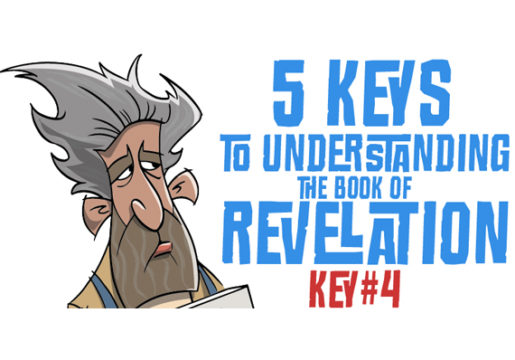
KEY#4: REVELATION IS WRITTEN CHRONOLOGICALLY
In previous posts we’ve looked at the first three keys. (1.) (2.) (3.) — and today we’ll look at the fourth key. Many Christians don’t realize that Revelation is written chronologically (with a few parenthetical sections that provide further detail). This was eye opening to me the first time I realized it.
There are four main ways people have viewed Revelation over the centuries. Idealist, Preterist, Historicist, and Futurist.
The Idealist View allegorizes Revelation but we’ve shown the main problems with that method — primarily that man can allegorize Revelation to mean just about anything their imaginations come up with. Also, if you can allegorize one section of scripture, what’s to say you can’t allegorize the entire Bible? Where does it stop? The Idealist view causes scripture to lose it’s meaning.
The Preterist View claims that everything in Revelation has already happened in the past (namely in 70 AD when the Romans destroyed Jerusalem) but there are major problems with this view as well. The main problem being that John wrote the book of Revelation around 95 AD while exiled on the Island of Patmos; about 15 years after the fall of Jerusalem. This view also allegorizes various things found in Revelation and we run into the same problem as the Idealist View mentioned above. A final major problem with this view is that Revelation clearly details a complete and decisive defeat of Satan at Christ’s return, a great “White Throne” judgement of evil-doers and several other major events which clearly have not occurred yet.
The Historicist View sees Revelation as a symbolic representation of the entire course of History from John’s time to the end of history. This view was popular during the Reformation era but has many problems and has led to as many as 50 versions of this view. It simply does not work.
Finally, the Futurist View teaches that the events in Revelation will occur in the future. Revelation claims to be prophecy. Prophecy is by nature, future. As mentioned in Key#2, this view interprets Revelation literally — just as we do with the rest of scripture. Where symbols are used we find the answers in the immediate or broader context of scripture, not from our own ideas.
It’s important to note that very smart Bible-believing Christians may hold different views and that this is an “in-house” debate. Salvation does not depend on one’s view of Revelation. Truth does matter, however, and beliefs lead to choices which effect the world around us.
After countless hours of careful study and after reading over 50 books on the topic by the most highly respected prophecy experts of the past few generations (Walvoord, Pentecost, Morris, LeHaye, Ice, Rhodes, Reagan, Missler…to name a few) I am convinced that the Futurist view is without doubt the correct and most thoroughly Biblical view.
All of that said, we find in the Book of Revelation some key “in text” reasons confirming the book is written chronologically. Our first clue is found in chapter 1 where Jesus himself provides the simplest outline ever given for the book of Revelation. In verse 19 the glorified Lord said to John, “Write the things which you have seen, and the things which are, and the things which will take place after this.”
So, we have…
I. THINGS YOU HAVE SEEN – Glorified Christ in Heaven (Ch. 1 vs. 12-18)
II. THINGS WHICH ARE – having to do with the 7 churches (Ch. 2-3)
III. THINGS THAT TAKE PLACE AFTER – Future/Tribulation/Kingdom/Eternity (Ch. 4-22)
There’s your outline for the book of Revelation.
There are also specific phrases throughout Revelation demonstrating that it is written in chronological order. Phrases like “after this”, “when he had opened the seventh seal”, “the seven last plagues”, and “after these things”. These are time-oriented sequential phrases and there is a natural progression and build up of events throughout the book. Even the seal, trumpet, and bowl judgements are each numbered in order from one through seven.
The only sections that are not in clear chronological order are Chapters 10-14, but they are clearly parenthetical chapters providing more detail on other portions of the book of Revelation. It’s almost like an intermission in the middle of the book. After the seal and trumpet judgements, John pauses to provide more detail and to let you catch your breath. Then he picks back up in chapter 15 with the bowl judgements.
When you compare Revelation with Daniel as we mentioned in Key #1, the chronology of both books is the same and they fit together like an interlocking puzzle. Each book stands on it’s own but sheds further light on the other.
I hope this key helps you in your study of Revelation!
RESOURCES FOR FURTHER STUDY
Here are a few GREAT books to get if you would like to dig deeper.
The Revelation Record: A Scientific and Devotional Commentary on the Prophetic Book of the End of Times (Morris)
40 Days Through Revelation: Uncovering the Mystery of the End Times (Rhodes)
Charting the End Times: A Visual Guide to Understanding Bible Prophecy (LaHaye/Ice)
Every Prophecy of the Bible: Clear Explanations for Uncertain Times (Walvoord)
The End Times in Chronological Order (Rhodes)
Exploring Bible Prophecy from Genesis to Revelation (LaHaye/Hindson)
